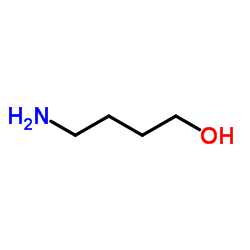4-Amino-1-butanol

4-Amino-1-butanol structure
|
Common Name | 4-Amino-1-butanol | ||
|---|---|---|---|---|
| CAS Number | 13325-10-5 | Molecular Weight | 89.14 | |
| Density | 0.9±0.1 g/cm3 | Boiling Point | 206.0±0.0 °C at 760 mmHg | |
| Molecular Formula | C4H11NO | Melting Point | 16-18 °C(lit.) | |
| MSDS | Chinese USA | Flash Point | 107.8±0.0 °C | |
| Symbol |

GHS05 |
Signal Word | Danger | |
|
Polymeric nanoparticles for nonviral gene therapy extend brain tumor survival in vivo.
ACS Nano 9(2) , 1236-49, (2015) Biodegradable polymeric nanoparticles have the potential to be safer alternatives to viruses for gene delivery; however, their use has been limited by poor efficacy in vivo. In this work, we synthesize and characterize polymeric gene delivery nanoparticles an... |
|
|
Dual Stimuli-Responsive Poly(β-amino ester) Nanoparticles for On-Demand Burst Release.
Macromol. Biosci. 15 , 1314-22, (2015) We designed poly(β-amino esters) (PBAEs) bearing both UV light- and pH-sensitive groups and used PBAEs to prepare nanoparticles (NPs) that can be utilized for on-demand burst release of guest molecules in response to multiple triggers. Due to the presence of ... |
|
|
Charge-transfer complexes of 4-nitrocatechol with some amino alcohols.
Spectrochim. Acta. A. Mol. Biomol. Spectrosc. 75(3) , 970-7, (2010) Charge-transfer (CT) complexes formed from the reactions of 4-nitropyrocatechol (4-nCat) as an electron acceptor with four amino alcohols: 2-aminoethanol, 1-amino-2-propanol, 4-aminobutanol and N-(2-hydroxyethyl)-1,3-diaminopropane (NHEDAP) as electron donors... |
|
|
Chemoenzymatic construction of a four-component Ugi combinatorial library.
Biotechnol. Bioeng. 69(4) , 457-60, (2000) The chemoenzymatic preparation of a nine-member Ugi condensation library is described. The carboxylic acid and amine precursors are based on 3-hydroxybutyrate and 4-amino-1-butanol, respectively, and have been acylated selectively using a variety of acyl dono... |
|
|
Nonviral direct conversion of primary mouse embryonic fibroblasts to neuronal cells.
Mol. Ther. Nucleic Acids 1 , e32, (2013) Transdifferentiation, where differentiated cells are reprogrammed into another lineage without going through an intermediate proliferative stem cell-like stage, is the next frontier of regenerative medicine. Wernig et al. first described the direct conversion... |
|
|
Microfluidic preparation of polymer-nucleic acid nanocomplexes improves nonviral gene transfer.
Sci. Rep. 3 , 3155, (2013) As the designs of polymer systems used to deliver nucleic acids continue to evolve, it is becoming increasingly apparent that the basic bulk manufacturing techniques of the past will be insufficient to produce polymer-nucleic acid nanocomplexes that possess t... |
|
|
Physicochemical and biological evaluation of siRNA polyplexes based on PEGylated Poly(amido amine)s.
Pharm. Res. 29 , 352-61, (2012) Use of RNA interference as novel therapeutic strategy is hampered by inefficient delivery of its mediator, siRNA, to target cells. Cationic polymers have been thoroughly investigated for this purpose but often display unfavorable characteristics for systemic ... |
|
|
Two different models to predict ionic-liquid diffraction patterns: fixed-charge versus polarizable potentials.
ChemPhysChem 16(1) , 197-203, (2015) This study reports the performance of classical molecular dynamics (MD) in predicting the X-ray diffraction patterns of butylammonium nitrate (BAN) and two derivatives, 4-hydroxybutan-1-ammonium nitrate (4-HOBAN) and 4-methoxybutan-1-ammonium nitrate (4-MeOBA... |
|
|
Biodegradable DNA Nanoparticles that Provide Widespread Gene Delivery in the Brain.
Small 12 , 678-85, (2016) Successful gene therapy of neurological disorders is predicated on achieving widespread and uniform transgene expression throughout the affected disease area in the brain. However, conventional gene vectors preferentially travel through low-resistance perivas... |
|
|
Optimization of poly(amido amine)s as vectors for siRNA delivery.
J. Control. Release 150(2) , 177-86, (2011) By Michael addition polymerization of N,N'-cystaminebisacrylamide (CBA) with variable ratios of 4-amino-1-butanol (ABOL) and ethylene diamine (EDA) or triethylenetetramine (TETA), poly(amido amine) copolymers could be obtained with tunable charge densities. T... |